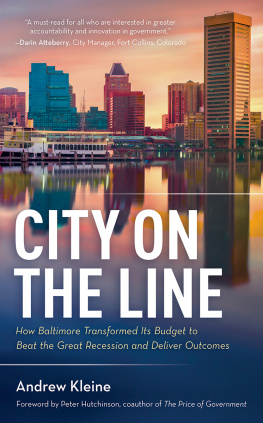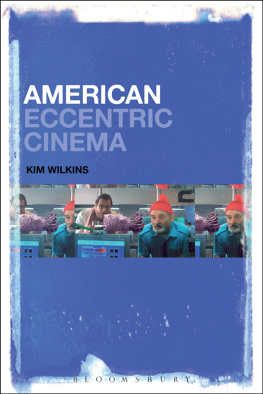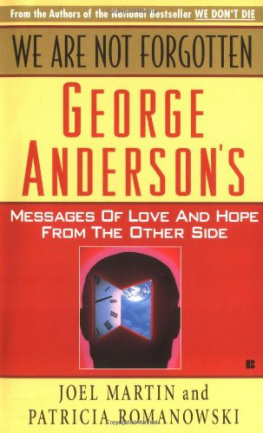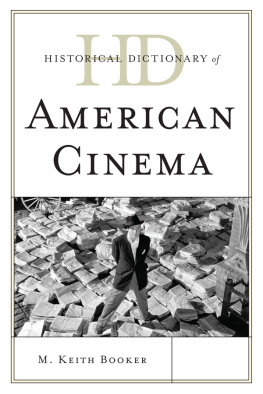CULTURAL HISTORIES OF CINEMA
This new book series examines the relationship between cinema and culture. It will feature interdisciplinary scholarship that focuses on the national and transnational trajectories of cinema as a network of institutions, representations, practices and technologies. Of primary concern is analysing cinemas expansive role in the complex social, economic and political dynamics of the twentieth and twenty-first centuries.
SERIES EDITORS
Lee Grieveson and Haidee Wasson
ALSO PUBLISHED
Cinema Beyond Territory: Inflight Entertainment and
Atmospheres of Globalisation, Stephen Groening
Empire and Film, edited by Lee Grieveson and Colin MacCabe
Film and the End of Empire, edited by Lee Grieveson and Colin MacCabe Global Mexican Cinema: Its Golden Age, Robert McKee Irwin and Maricruz Castro Ricalde
(with Mnica Szurmuk, Inmaculada lvarez and dubravka Sunjevi The Grierson Effect: Tracing Documentarys International Movement,
edited by Zo druick and deane Williams
Making Movies into Art: Picture Craft from the Magic Lantern to Early Hollywood,
Kaveh Askari
Shadow Economies of Cinema: Mapping Informal Film Distribution, Ramon Lobato
I owe my deepest gratitude to Jan Olsson, for his extraordinary mentorship over the years, and for his support at every stage of researching and writing this book. This includes incomparable intellectual stimulation as well as practical aid. Specifically, I was extremely fortunate to be drafted by Jan for his research project From Business Commodities to Revered Cultural Heritage: Global Media, Vernacular Strategies, and Cultural Negotiations, which received funding from the Swedish Research Council from 2010 to 2013, and which afforded me the opportunity to do research on George Kleine under fabulous conditions.
I cannot thank series editors Lee Grieveson and Haidee Wasson enough for their efforts in bringing this book into existence, and for the enthusiasm and encouragement they extended to me from first proposal to final typescript. Likewise, it has been a pleasure and privilege to work with the stellar editors at BFI Publishing/Palgrave, including Jenni Burnell, Jenna Steventon and Lucy Knight (who jointly took over after Jenni in August 2014), and Sophie Contento.
I would also like to thank Richard Abel and Kingsley Bolton, who offered crucial support to the project by kindly issuing letters of recommendation for my application for a fellowship at the John W. Kluge Center at the Library of Congress. This made possible an uninterrupted six-month stint at the Library from September 2012 to March 2013.
Charles Musser generously agreed to participate as respondent in a panel I chaired at the Society for Cinema and Media Studies Conference in Chicago in March 2013. The constructive criticism and intellectual inspiration he provided was immensely valuable to me, and a boon to the panel. I would also like to thank Liz Clarke, for initiating this panel and organising it with me, but also for friendship and good banter, and for carrying out a small but significant research mission in LA on my part in a late phase of the project.
Closer to home, friends and co-workers at the Section for Cinema Studies at Stockholm University have made life at Filmhuset a treat. I owe a particularly great deal of gratitude to Marina Dahlquist, colleague extraordinaire. Ive learned much (and keep learning) from Marina, but I should also specifically mention a symposium on educational cinema that we co-hosted in May 2013, and that influenced the Kleine project in important ways. Im thankful to Marina for this, and to the participants at the symposium for their much-appreciated input. They included Zo Druick, Oliver Gaycken, Lee Grieveson, Frank Kessler, Nico de Klerk, Sabine Lenk, Paul S. Moore and Greg Waller.
Earlier in 2013, during my prolonged stay in Washington, DC, Oliver Gaycken kindly invited me to give a guest talk on Kleine at the University of Maryland, College Park. Im grateful to Oliver for this, and for the intelligent questions and criticism he formulated on this occasion. The practical arrangements were handled by Brian Real, to whom I owe thanks for this, but also for inviting me to all kinds of film-related events in the DC area, and for taking me on a memorable tour of some of the excellent breweries located in the same region.
The anonymous reviewers of the book proposal offered truly constructive comments and suggestions regarding the books structure, scope and focus. As the manuscript began to take shape, Doron Galilis input helped tremendously. Later, Anitra Grisales provided editing and feedback with a remarkable degree of precision, clarity and insight. Im equally grateful to the anonymous reader who stepped in later, and who presented deeply knowledgeable and useful criticism that informed the revision phase. In the final stages, Philippa Hudsons exceptionally skilful copy editing was indispensable in bringing the manuscript to completion.
The research for this book involved numerous visits long and short to the Library of Congress. I would like to extend a heartfelt thanks to the people who work there, in particular the staffs of the Manuscript Division; the Motion Pictures, Broadcasting and Recorded Sound Division; and the Prints and Photographs Division. Many thanks also to the staff at the John W. Kluge Center, especially Mary Lou Reker, Carolyn Brown, Jason Steinhauer and Travis Hensley, who took such great care of me while there; to the visiting scholars who made the centre such a vibrant scholarly environment; and to Charlotte Hanstad, my research assistant during the last few weeks of the fellowship.
Im also indebted to a number of librarians and archivists in New York City, including the respective staffs of the Rare Books Division at the New York Public Library; the New York Public Library for the Performing Arts; the Museum of Modern Art Library; and the Museum of Modern Art Film Study Center. Thanks also to the reference librarians at the Archibald S. Alexander Library at Rutgers University, New Brunswick.
The visits to these libraries and archives would not have been possible without economic backing from several institutions. They include the Swedish Research Council; the John W. Kluge Center; and the Lauritzen Foundation for Film Historical Research. Im also grateful to the Royal Swedish Academy of Letters, History and Antiquities, and the Knut and Alice Wallenberg Foundation, both of which sponsored trips to international conferences where I had the opportunity to present my work-in-progress.
Whether she travelled with me in person on these voyages or not, I am lucky beyond belief that Caroline was always there, and that she keeps bringing love and laughter into my life every day. No longer do we wonder
George Kleine (18631931) kept most details of his private life out of the public eye. When a reporter from the Cleveland Plain dealer interviewed him in July 1913, Kleine declared that there was nothing interesting, romantic, or sensational about him. Yet his story remains largely untold.
Notwithstanding a certain lack of biographical drama and personal flamboyance, Kleines career makes up a fascinating story and offers a unique entry point into the rich complexity and wondrous diversity of American cinemas past. Kleine was born and raised in New York City, learned the opticians trade in his fathers optical store in Manhattan and moved to Chicago in 1893 to set up his own shop. When motion picture equipment and films became commercially viable in 1896, he added them to the product line. By the time of the nickelodeon boom in 1905 and 1906, thanks to a combination of fortunate circumstances and entrepreneurial prowess, his Kleine Optical Company had become the largest importer and distributor of motion pictures in the United States, and Kleine himself had become a pivotal figure in the American motion picture business. Over the next couple of years, he inaugurated a network of film rental exchanges in key cities across the United States and Canada. In late 1908, the Motion Picture Patents Company (MPPC) was formed in an attempt to assume oligopolistic control of the business through patent rights. Kleine was a founding member of the MPPC, and the largest stockholder in its distribution branch, the General Film Company (GFC, operative from 1910). Parallel to his work within the MPPC, he began to cultivate the market for a new type of motion picture: the multi-reel feature film. Kleine pioneered this field, most notably through the importation and exploitation of












